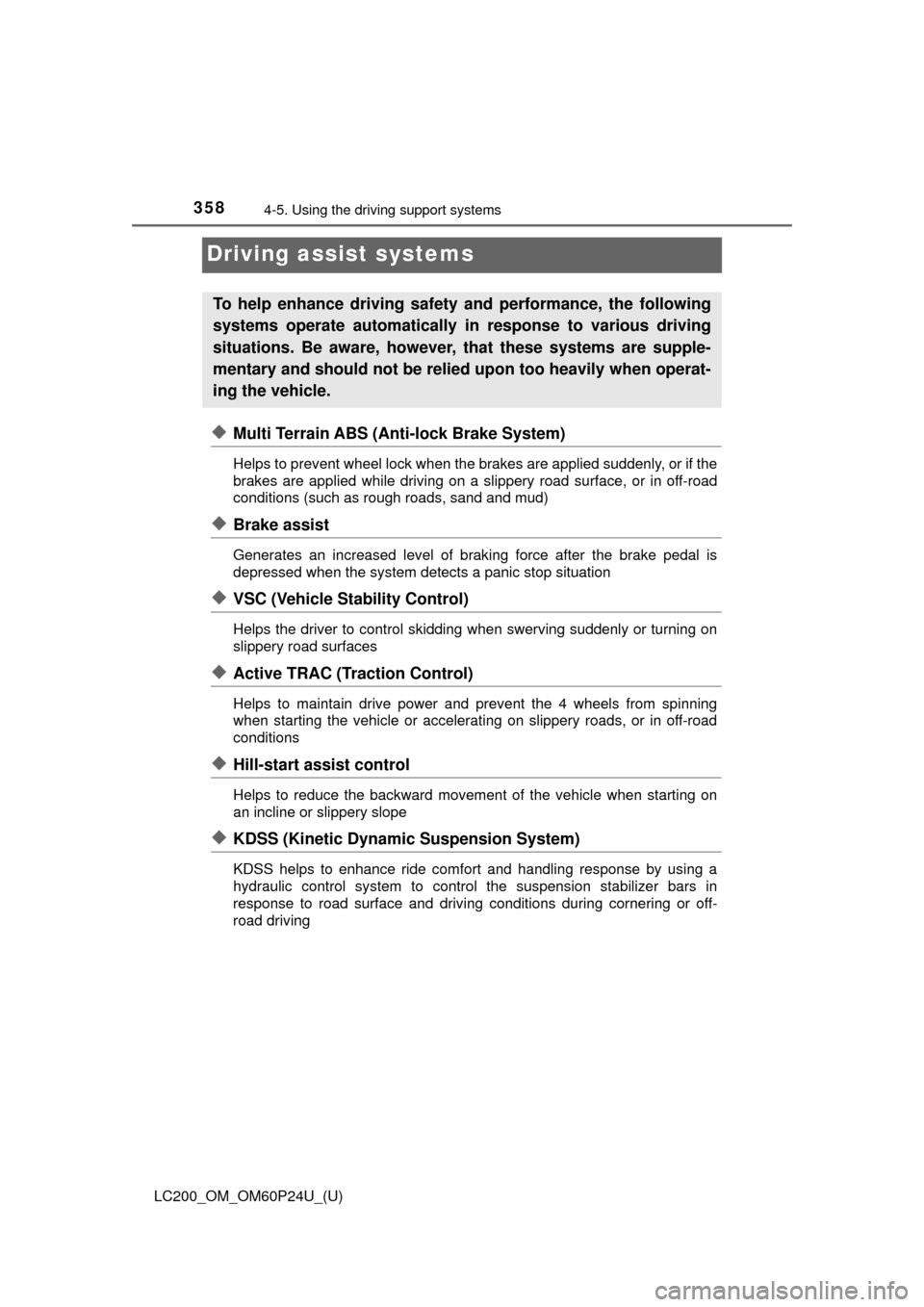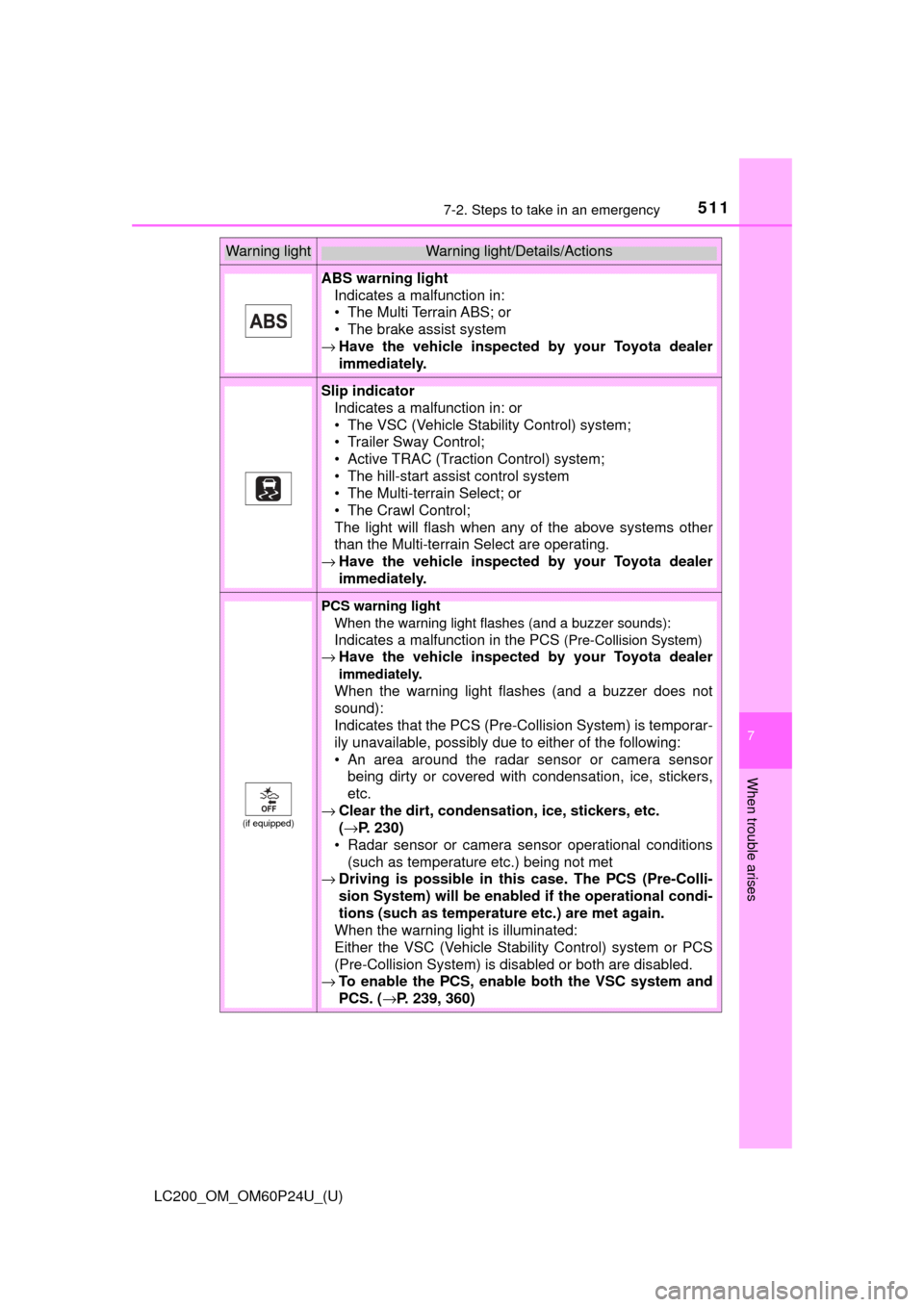2017 TOYOTA LAND CRUISER ABS
[x] Cancel search: ABSPage 358 of 608

358
LC200_OM_OM60P24U_(U)
4-5. Using the driving support systems
Driving assist systems
◆Multi Terrain ABS (Anti-lock Brake System)
Helps to prevent wheel lock when the brakes are applied suddenly, or if the
brakes are applied while driving on a sl ippery road surface, or in off-road
conditions (such as rough roads, sand and mud)
◆Brake assist
Generates an increased level of braking force after the brake pedal is
depressed when the system detects a panic stop situation
◆VSC (Vehicle Stability Control)
Helps the driver to control skidding when swerving suddenly or turning on
slippery road surfaces
◆Active TRAC (Traction Control)
Helps to maintain drive power and prevent the 4 wheels from spinning
when starting the vehicle or accelerati ng on slippery roads, or in off-road
conditions
◆Hill-start assist control
Helps to reduce the backward movement of the vehicle when starting on
an incline or slippery slope
◆KDSS (Kinetic Dynamic Suspension System)
KDSS helps to enhance ride comfort and handling response by using a
hydraulic control system to control the suspension stabilizer bars in
response to road surface and driving conditions during cornering or off-
road driving
To help enhance driving safety and performance, the following
systems operate automatically in response to various driving
situations. Be aware, however, that these systems are supple-
mentary and should not be relied upon too heavily when operat-
ing the vehicle.
Page 361 of 608

LC200_OM_OM60P24U_(U)
3614-5. Using the driving support systems
4
Driving
■Automatic reactivation of Active TR AC, VSC and Trailer Sway Control
Turning the engine switch off after turning off the Active TRAC and VSC sys-
tems will automatically re-enable them.
■ Automatic Active TRAC reactivation
If only the Active TRAC system is turned off, the Active TRAC system will turn
on when vehicle speed increases.
■ Automatic Active TRAC, VSC and Tr ailer Sway Control reactivation
If the Active TRAC, VSC and Trailer Sway Control are turned off, the systems
will not turn on even when vehicle speed increases.
■ If the brake system overheats
The brake system may overheat. In this case, a buzzer will sound, and the
TRAC OFF indicator will flash, and Acti ve TRAC and hill-start assist control
will be temporarily inoperable. In this event, stop the vehicle immediately in a
safe place, and allow the brake system to cool down sufficiently until the
TRAC OFF indicator go off. (There is no problem with continuing normal driv-
ing.)
■ Sounds and vibrations caused by the Multi Terrain ABS, brake assist,
Active TRAC, VSC, Trailer Sway Co ntrol, hill-start assist control and
VGRS
● A sound may be heard from the engine compartment when the engine is
started or just after the vehicle begins to move. This sound does not indicate
that a malfunction has occurred in any of these systems.
● Any of the following conditions may occur when the above systems are
operating. None of these indicates that a malfunction has occurred.
• Vibrations may be felt through the vehicle body and steering.
• A motor sound may be heard after the vehicle comes to a stop.
• The brake pedal may pulsate slightly after the Multi Terrain ABS is acti-
vated.
• The brake pedal may move down slightly after the Multi Terrain ABS is activated.
■ Hill-start assist control is operational when
●The shift lever is in D or S.
● The brake pedal is not depressed.
■ VGRS is disabled in the following situations
●During stopping or the steering wheel has been moved for a long time while
driving at lower speeds.
● After the engine is restarted at less than -22 °F (-30 °C).
● If you disconnect the battery with the steering wheel turned, the center\
posi-
tion of the steering wheel could be slightly and temporary hanged. To initial-
ize the VGRS, drive for a short while.
Page 362 of 608

362
LC200_OM_OM60P24U_(U)
4-5. Using the driving support systems
WARNING
Any of the following conditions may result in an accident which could cause
death or serious injury:
■The Multi Terrain ABS does not operate effectively when
● The limits of tire gripping performance have been exceeded (such as
excessively worn tires on a snow covered road).
● The vehicle hydroplanes while driving at high speed on the wet or slick
road.
■ Stopping distance when the Multi Terrain ABS is operating may exceed
that of normal conditions
The Multi Terrain ABS is not designed to shorten the vehicle’s stopping dis-
tance. Always maintain a safe distance from the vehicle in front of you,
especially in the following situations.
● When driving on dirt, gravel or snow-covered roads
● When driving with tire chains
● When driving over bumps in the road
● When driving over roads with potholes or uneven roads
■ Active TRAC may not operate effectively when
Directional control and power may not be achievable while driving on slip-
pery road surfaces, even if the Active TRAC is operating.
Do not drive the vehicle in conditions where stability and power may be lost.
■ If the hill-start assist contro l does not operate effectively
Do not overly rely on the hill-start assist control. The hill-start assist control
may not operate effectively on steep inclines and roads covered in ice.
■ When Active TRAC, VSC and Trailer Sway Control are off
Be especially careful and drive at a speed appropriate to the road condi-
tions. As there are systems to help ensure vehicle stability and driving force,
do not turn off Active TRAC, VSC and Trailer Sway Control unless neces-
sary.
Page 363 of 608

LC200_OM_OM60P24U_(U)
3634-5. Using the driving support systems
4
Driving
WARNING
■When the VSC and Trailer Sway Control are activated
The slip indicator light flashes. Always drive carefully.
Reckless driving may cause an accident. Exercise particular care when the
indicator light flashes.
■
Replacing tires
Make sure that all tires are of the same size, brand, tread pattern and
total load capacity. In addition, make sure that the tires are inflated to
the specified tire pressure level.
The Multi Terrain ABS, Active TRAC, VSC and Trailer Sway Control will
not function correctly if differen t tires are fitted on the vehicle.
Contact your Toyota dealer for furt her information when replacing tires
or wheels.
■Handling of tires and suspension
Using tires with any kind of problem or modifying the suspension will
affect the driving assist systems, and may cause the system to malfunc-
tion.
■ Trailer Sway Control precaution
The Trailer Sway Control system is not able to reduce trailer sway in all situ-
ations. Depending on many factors such as the conditions of the vehicle,
trailer, road surface, and driving environment, the Trailer Sway Control sys-
tem may not be effective. Refer to your trailer owner’s manual for informa-
tion on how to tow your trailer properly.
■ If trailer sway occurs
Observe the following precautions.
Failing to do so may cause death or serious injury.
● Firmly grip the steering wheel. Steer straight ahead.
Do not try to control trailer swaying by turning the steering wheel.
● Begin releasing the accelerator pedal immediately but very gradually to
reduce speed.
Do not increase speed. Do not apply vehicle brakes.
If you make no extreme correction with the steering or brakes, your vehicle
and trailer should stabilize. (→P. 189)
Page 457 of 608

LC200_OM_OM60P24U_(U)
4576-3. Do-it-yourself maintenance
6
Maintenance and care
■Brake fluid can absorb moisture from the air
Excess moisture in the fluid can cause a dangerous loss of braking efficiency.
Use only newly opened brake fluid.
WARNING
■ When filling the reservoir
Take care because brake fluid can harm your hands or eyes and damage
painted surfaces. If fluid gets on your eyes, flush the affected area with
clean water immediately. If you still experience discomfort, see a doctor.
NOTICE
■If the fluid level is low or high
It is normal for the brake fluid level to go down slightly as the brake pads
wear or when the fluid level in the accumulator is high. If the reservoir needs
frequent refilling, it may indicate a serious problem.
Page 511 of 608

5117-2. Steps to take in an emergency
LC200_OM_OM60P24U_(U)
7
When trouble arises
ABS warning lightIndicates a malfunction in:
• The Multi Terrain ABS; or
• The brake assist system
→ Have the vehicle inspected by your Toyota dealer
immediately.
Slip indicator
Indicates a malfunction in: or
• The VSC (Vehicle Stability Control) system;
• Trailer Sway Control;
• Active TRAC (Traction Control) system;
• The hill-start assist control system
• The Multi-terrain Select; or
• The Crawl Control;
The light will flash when any of the above systems other
than the Multi-terrain Select are operating.
→ Have the vehicle inspected by your Toyota dealer
immediately.
(if equipped)
PCS warning light
When the warning light flashes (and a buzzer sounds):
Indicates a malfunction in the PCS
(Pre-Collision System)
→ Have the vehicle inspected by your Toyota dealer
immediately.
When the warning light flashes (and a buzzer does not
sound):
Indicates that the PCS (Pre-Collision System) is temporar-
ily unavailable, possibly due to either of the following:
• An area around the radar sensor or camera sensor
being dirty or covered with condensation, ice, stickers,
etc.
→ Clear the dirt, condensation, ice, stickers, etc.
(→P. 230)
• Radar sensor or camera sensor operational conditions
(such as temperature etc.) being not met
→ Driving is possible in th is case. The PCS (Pre-Colli-
sion System) will be enabled if the operational condi-
tions (such as temperature etc.) are met again.
When the warning light is illuminated:
Either the VSC (Vehicle Stability Control) system or PCS
(Pre-Collision System) is disabled or both are disabled.
→ To enable the PCS, enable both the VSC system and
PCS. ( →P. 239, 360)
Warning lightWarning light/Details/Actions
Page 516 of 608

5167-2. Steps to take in an emergency
LC200_OM_OM60P24U_(U)■
Warning buzzer
In some cases, the buzzer may not be heard due to being in a noisy location
or audio sound.
WARNING
■If both the ABS and the brake system warning lights remain on
Stop your vehicle in a safe place immediately and contact your Toyota
dealer. The vehicle will become extremely unstable during braking, and the
ABS system may fail, which could cause an accident resulting in death or
serious injury.
■
If the tire pressure warning light comes on
Be sure to observe the following precautions. Failure to do so could
cause loss of vehicle control and result in death or serious injury.
●Stop your vehicle in a safe place as soon as possible. Adjust the tire
inflation pressure immediately.
●If the tire pressure warning light co mes on even after tire inflation pres-
sure adjustment, it is probable that you have a flat tire. Check the tires.
If the tire is flat, change to the spare tire and have the flat tire repaired
by the nearest Toyota dealer.
●Avoid abrupt maneuvering and braking. If the vehicle tires deteriorate,
you could lose control of the steering wheel or the brakes.
■If a blowout or sudden air leakage should occur
The tire pressure warning system may not activate immediately.
Page 592 of 608

592Alphabetical index
LC200_OM_OM60P24U_(U)
Alphabetical index
A/C .................................... 374, 385Air conditioning filter ............. 477
Changing the rear seat
settings ............................... 378
Front automatic air
conditioning system ............ 374
Micro dust and pollen filter .... 380
Rear air conditioning system ......... ....................... 385
ABS (Anti-lock Brake System) .................................. 358
Function ................................ 358
Warning light ......................... 511
Active head restraint ............... 127
Active TRAC ............................. 358
Air cleaner ................................ 448
Air conditioning filter .............. 477
Air conditioning
system ............................ 374, 385 Air conditioning filter ............. 477
Changing the rear seat
settings ............................... 378
Front automatic air
conditioning system ............ 374
Micro dust and pollen filter .... 380
Rear air conditioning system ......... ....................... 385 Airbags ....................................... 38
Airbag operating conditions .... 46
Airbag precautions for
your child .............................. 41
Airbag warning light .............. 510
Correct driving posture ........... 28
Curtain shield airbag operating conditions ............. 46
Curtain shield airbag precautions........................... 44
Front passenger occupant
classification syst em ............ 51
General airbag precautions .... 41
Locations of airbags ............... 38
Modification and disposal of airbags ............................. 45
“RSCA OFF” switch ................ 50
Side airbag operating
conditions ............................. 46
Side airbag precautions .......... 43
Side and curtain shield
airbags operating
conditions ............................. 46
Side and curtain shield airbags precautions .............. 44
SRS airbags ........................... 38
Alarm .......................................... 76
Alarm ...................................... 76
Warning buzzer .................... 510
Anchor brackets ........................ 63
Antenna
Smart key system ................. 120
A